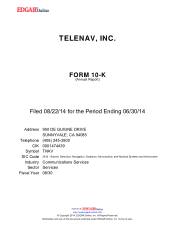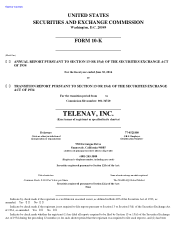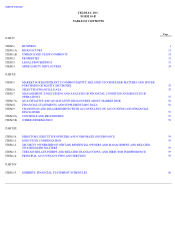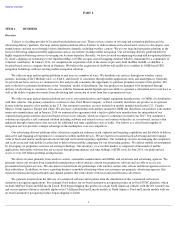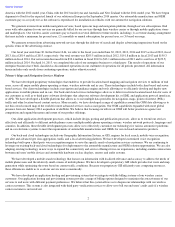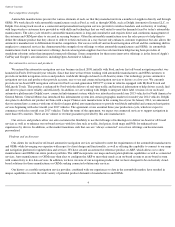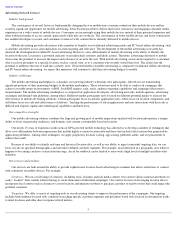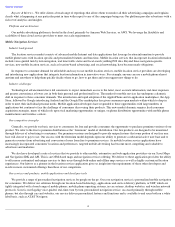TeleNav 2014 Annual Report Download - page 7
Download and view the complete annual report
Please find page 7 of the 2014 TeleNav annual report below. You can navigate through the pages in the report by either clicking on the pages listed below, or by using the keyword search tool below to find specific information within the annual report.
Table of Contents
America with the 2012 model year, China with the 2013 model year and Australia and New Zealand with the 2014 model year. We have begun
shipments to Ford for the expected launch of our solution in Europe in the September 2014 quarter. Our automobile manufacturer and OEM
customers pay us a royalty fee as the software is reproduced for installation in vehicles with our automotive navigation solutions.
We generate revenue from mobile navigation services, based upon our map and navigation platform, through service subscriptions. End
users with subscriptions for our services are generally billed for our services through their wireless carrier or through mobile application stores
and marketplaces. Our wireless carrier customers pay us based on several different revenue models, including (1) a revenue sharing arrangement
that may include a minimum fee per end user, (2) a monthly or annual subscription fee per end user, or (3) based on usage.
We generate revenue from advertising network services through the delivery of search and display advertising impressions based on the
specific terms of the advertising contract.
Our fiscal year ends June 30. In this Form 10-K, we refer to the fiscal year ended June 30, 2012, 2013, 2014 and 2015 as fiscal 2012, fiscal
2013, fiscal 2014 and fiscal 2015, respectively. Our total revenue was $205.5 million in fiscal 2012, $191.8 million in fiscal 2013 and $150.3
million in fiscal 2014. Our net income decreased from $32.4 million in fiscal 2012 to $13.1 million in fiscal 2013 and to a net loss of $(29.5)
million in fiscal 2014. On April 16, 2013, we completed the sale of our enterprise business to a third party. The results of operations of our
enterprise business have been classified as discontinued operations in our statement of operations for all periods presented. All information
herein includes only results from continuing operations, unless otherwise noted.
Telenav's Maps and Navigation Services Platform
We have developed proprietary technologies that enable us to provide location-based mapping and navigation services to millions of end
users, across all major mobile phone operating systems, wireless networks and in cars. These technologies include both client based and server
based services. Our client technologies include a navigation and guidance engine and tools allowing us to efficiently develop and deploy new
applications to mobile phones and in cars. Our back-end cloud services technologies allow us to deliver real-time location-
based data for users of
our customers as well as to third party software developers that adopt our software development kit, or SDK, and application protocol interfaces,
or APIs. We have developed a flexible platform that allows us to use multiple data providers for navigation, maps, points of interest (POIs),
traffic and other location-based content services. More recently, we have developed a range of capabilities around the OSM data allowing us to
use this crowd sourced map of the world for more advanced services such as navigation. Our OSM capabilities expanded with more global
presence from our January 2014 acquisition of skobbler. We believe that focusing our efforts on OSM will better position us against our
competition and expand the nature and extent of our product offerings.
Our client application development processes, which include design, porting and publication processes, allow us to extend our services
effectively and efficiently to different mobile phones across multiple mobile phone operating systems, wireless network protocols, languages and
countries. In addition, these flexible development processes allow us to effectively customize our technology for various automotive platforms
and in-car electronic systems to meet the requirements of automobile manufacturers and OEMs for our on-board automotive products.
Our back-end cloud technologies include our Geographic Information System, or GIS, engines for local search, mobile voice recognition,
geo alert and advanced geo data aggregation, traffic and a local advertising platform. We have developed customized voice recognition
technology built upon a third party voice recognition engine to serve the specific needs of navigation services customers. We are continuing to
leverage our existing back-end cloud technologies for deployment to the automobile manufacturer and OEM solution opportunities. We are also
adapting existing technology in new ways to expand the connectivity and service offerings for in-car experiences, including seamless interaction
between end users' mobile devices and automobile hardware such as displays, sensors and audio systems.
We have developed a mobile search technology that focuses on information with localized relevance and accuracy to address the needs of
mobile phone users and the relatively small screens of mobile phones. We have developed a proprietary GIS which provides fast route and map
generation while optimizing the route based on current traffic conditions. Because our proprietary GIS efficiently uses computing resources,
these efficiencies enable us to scale our servers more economically.
We have developed an application hosting and provisioning system that we integrate with the billing systems of our wireless carrier
customers. Our application hosting and provisioning system provides a range of billing options designed to maximize the attractiveness of our
services to end users with different payment preferences. We believe that this system allows us to deepen our relationships with our wireless
carrier customers. This system is also integrated with third party verification services to allow us to bill our end users' credit cards if a wireless
carrier customer is not involved.
2

